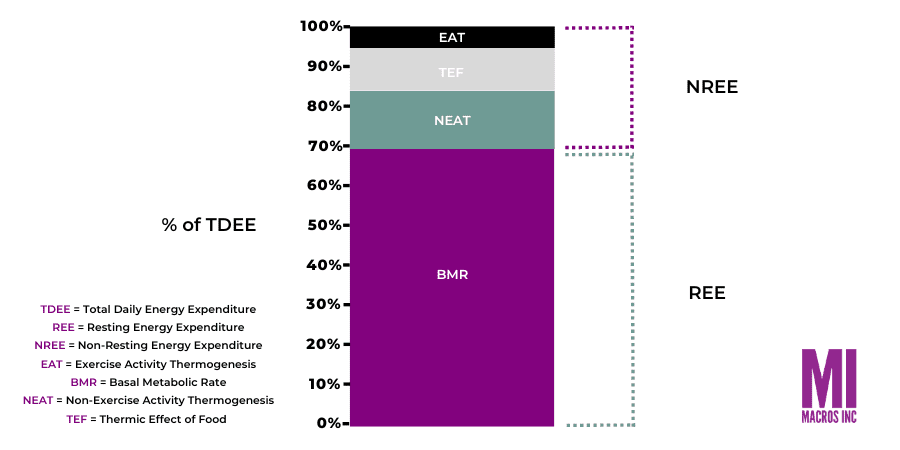If you’re looking to improve your physical health and achieve your fat loss goals, you’re in the right place. In this post, we’ll explore the intricate relationship between metabolism and fat loss and provide valuable insights and guidance based on our decades of experience as coaches.
Jump to a Topic
Losing Fat is Easy When You Know How
Losing body fat can be likened to solving an algebra problem. Just like how algebra seems complicated at first, with numbers mixed in with letters, fat loss may initially seem mysterious. However, with the right guidance, it becomes manageable and doable.
This is where working with a coach can be very helpful—they teach you how to navigate the “algebra” of fat loss. So, let’s delve into the core elements you need to understand.
Calories In – Calories Out (CICO)
Achieving fat loss is easier once you understand what controls your energy expenditure and energy intake. Energy intake, though challenging, is relatively straightforward—you measure and control the calories you eat through food. However, human behavior around food can complicate matters, which we’ll address later on in this post.
Energy expenditure, or calories out, is a bit more complex and often misunderstood. Let’s briefly touch upon its main components:
Basal Metabolic Rate (BMR)
Your basal metabolic rate represents the number of calories your body needs to perform basic functions at rest. It accounts for the largest portion of your total daily energy expenditure. Factors such as age, gender, body composition, and genetics influence your BMR. While you have limited control over it, certain strategies can help optimize it.
Resting Metabolic Rate (RMR)
Resting Metabolic Rate is often used interchangeably with BMR. It refers to the number of calories your body needs to sustain basic functions at rest, but with less stringent conditions than BMR measurements. RMR accounts for a similar amount of calories as BMR and is usually measured under relaxed conditions, such as in the morning after waking up. For practical purposes, BMR and RMR are often considered equivalent.
Thermic Effect of Food (TEF)
The thermic effect of food refers to the energy your body uses to digest, absorb, and process the food you consume. It is influenced by the types of foods you eat and their macronutrient composition. Protein, for example, has a higher thermic effect compared to fats and carbohydrates.
Exercise Activity (EAT)
Exercise activity ranks third in both total energy expenditure and its role in weight loss. Engaging in physical activity, whether cardiovascular exercises or resistance training, can increase your energy expenditure and promote fat loss. It also offers numerous other health benefits.
Non-Exercise Activity (NEAT)
Non-exercise activity represents your most significant lever when it comes to energy expenditure for fat loss. It encompasses your daily activities outside formal exercise—step count, time spent standing versus sitting, fidgeting, and opting for stairs instead of elevators. Increasing your overall movement throughout the day can contribute significantly to your fat loss efforts.

The Equation of Fat Loss
To simplify these concepts, the equation for fat loss looks like this:
X Pounds of Weight Loss = Food Consumed – (Resting Metabolic Rate + Thermic Effect of Food + Exercise Activity + Non-Exercise Activity).
If we prioritize these variables based on their impact on weight loss, the order would be:
- Food Consumed
- Non-Exercise Activity
- Exercise Activity
- Thermic Effect of Food
- Resting Metabolic Rate
Equation to Lose 1lb of Fat per Week
Suppose you’re aiming for a calorie deficit of 500 calories per day to lose fat. You consume 1,500 calories worth of food daily. Your resting metabolic rate (the calories your body needs to function at rest) is 1,500 calories per day.
The thermic effect of food (the energy your body uses to digest food) is estimated at 200 calories. You engage in 20 minutes of moderate-intensity exercise, burning 200 calories, and you have a non-exercise activity that burns 100 calories.
Now, let’s use the equation to calculate your potential weight loss:
X Pounds of Weight Loss = 1,500 (Food Consumed) – (1,500 (Resting Metabolic Rate) + 200 (Thermic Effect of Food) + 200 (Exercise Activity) + 100 (Non-Exercise Activity))
X Pounds of Weight Loss = 1,500 – (1,500 + 200 + 200 + 100)
X Pounds of Weight Loss = 1,500 – 2,000
X Pounds of Weight Loss = -500
With the adjusted food intake of 1,500 calories per day and exercise activity burning 200 calories, you are creating a daily calorie deficit of 500 calories (1,500 – 2,000).
Over a week, this would result in a total calorie deficit of 3,500 calories, which is equivalent to approximately 1 pound of fat loss.

Optimizing Your Metabolism for Fat Loss
Metabolism plays a crucial role in the fat loss process. By understanding how to optimize your metabolism, you can enhance your ability to burn fat. Here are some strategies to consider:
Strength Training
Engaging in regular strength training exercises can help increase your muscle mass. Muscle tissue is metabolically active and burns more calories at rest compared to fat tissue. By building lean muscle, you can elevate your resting metabolic rate and improve your fat-burning potential.
High-Intensity Interval Training (HIIT)
HIIT workouts involve short bursts of intense exercise followed by periods of recovery. This form of training can stimulate your metabolism, leading to an “afterburn” effect known as excess post-exercise oxygen consumption (EPOC). EPOC refers to the increased calorie burning that occurs post-workout as your body recovers.
Prioritize Protein
Including an adequate amount of protein in your diet is crucial for optimizing metabolism and supporting fat loss. Protein has a higher thermic effect compared to other macronutrients, meaning it requires more energy to digest and process. Additionally, protein helps preserve lean muscle mass during calorie restriction, which can help maintain a higher resting metabolic rate.
Manage Stress and Sleep
Chronic stress and inadequate sleep can negatively impact your metabolism. High levels of stress hormone cortisol can lead to increased fat storage, while poor sleep quality can disrupt metabolic processes. Prioritize stress management techniques and aim for quality sleep to support a healthy metabolism.
Understanding Your Weight Loss Timeline
When any of our clients start a weight loss journey we always give them this piece of advice: understand your timeline. One of the most important things you can do when you start off on a fat loss journey is have a good understanding of the timeline you are on.
The timelines aren’t complicated, but important to understand.
Let me use some rough math to highlight something for you.
Let’s say you want to lose 50 pounds. You can go after that 50 pounds in a few different scenarios.
Scenario 1:
The Super Disciplined Approach If you’re committed to being highly disciplined, increasing your activity level, and maintaining a consistent diet, you can likely achieve an average daily calorie deficit of 500. Assuming it takes approximately 3,500 calories to lose a pound, you can expect to lose around 1 pound per week. With the difficulty increasing as you progress, it’s reasonable to budget 55-60 weeks (over a year) to lose 50 pounds.
Scenario 2:
The Moderate Approach For those who prefer a more moderate approach, incorporating some exercise and maintaining approximately 20-30% diet consistency, your calorie deficit may average around 250 per day. This translates to a weight loss timeline of around 100 weeks (approximately two years) to achieve your goal.
Scenario 3:
The Hardcore Scenario For those who thrive on intensity and strict adherence, combining vigorous training, an intense calorie deficit, and never missing a day, you might achieve a calorie deficit of 750 per day. This results in a weight loss rate of approximately 1.5 pounds per week. In this scenario, you can expect to reach your goal in approximately 35 weeks (around 8 months).
When you start your fat loss journey, look at what option you are willing to do and set the appropriate timeline for you.
In Summary
Understanding the intricate relationship between metabolism and weight loss is key to achieving your fat loss goals effectively and sustainably. By controlling energy expenditure and energy intake, prioritizing the levers of fat loss, and implementing strategies to optimize your metabolism, you can embark on a successful fat loss journey.
Remember, seeking professional guidance can further enhance your chances of success. Wishing you the best on your path to improved physical health and well-being!
Try our nutrition coaching, for free!
Be the next success story. Over 30,000 have trusted Macros Inc to transform their health.
Simply fill out the form below to start your 14-day risk-free journey. Let's achieve your goals together!


